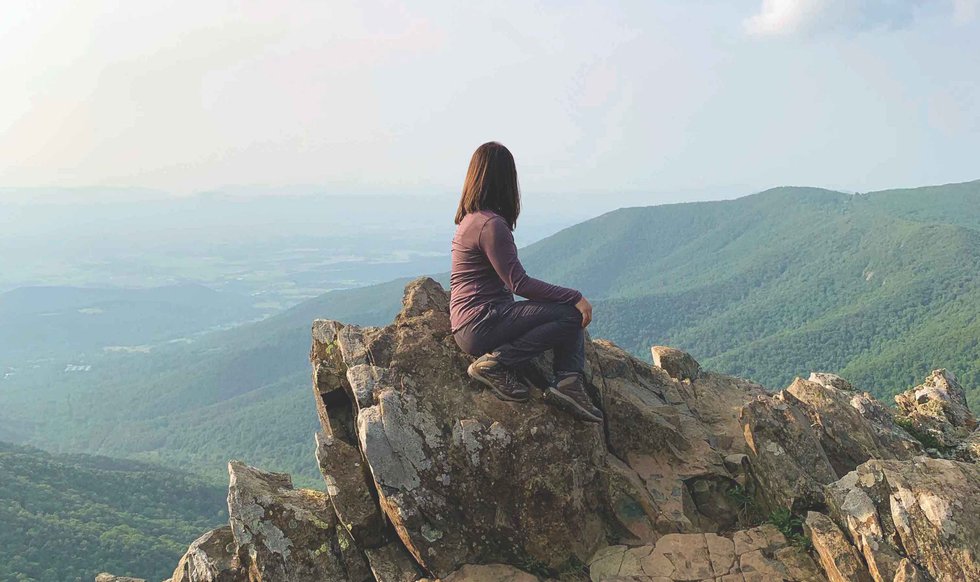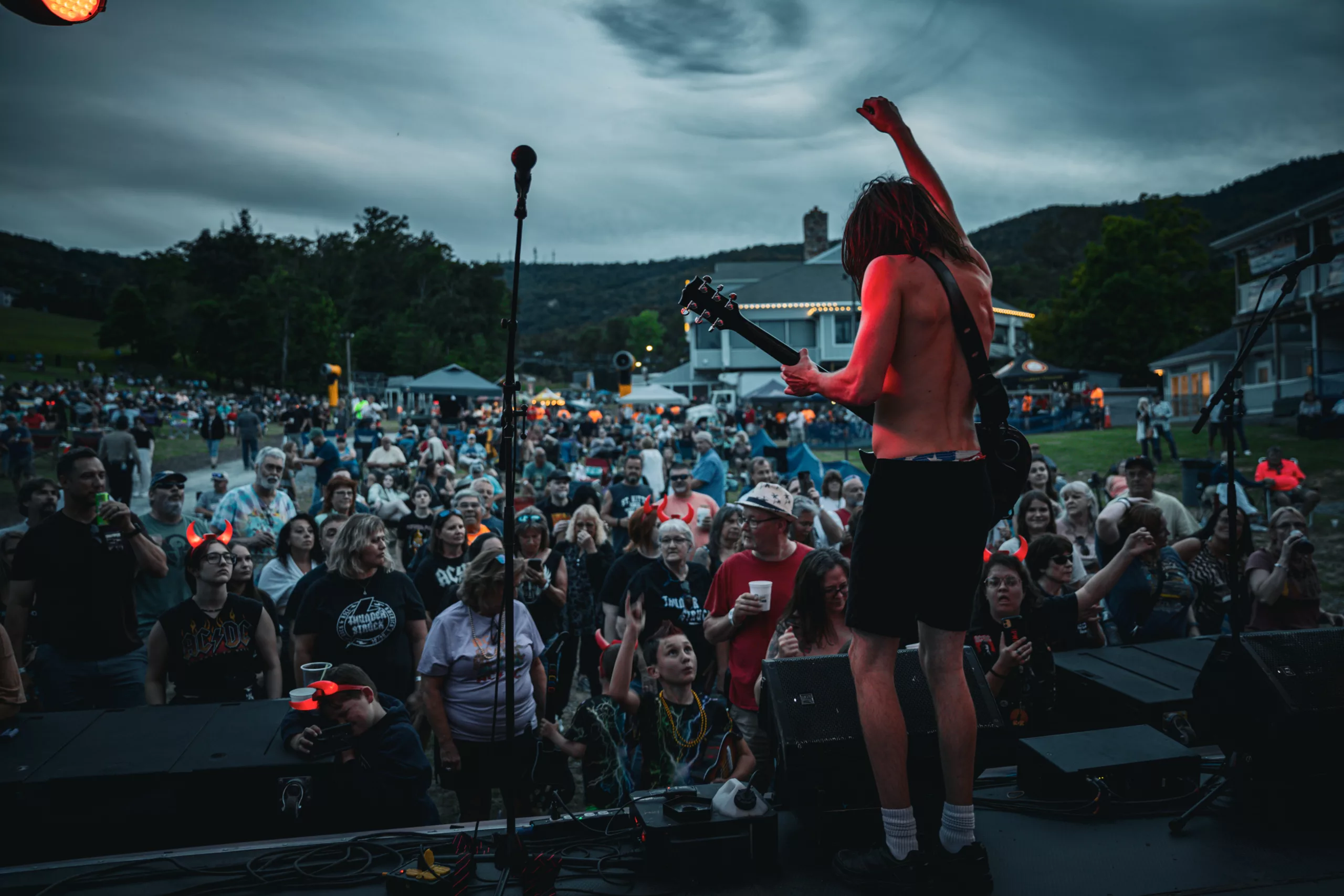Could Virginia be the world’s next healthiest place?

Hawksbill Mountain
Flourishing is a hot topic among scientists studying human health these days. Sure, we’d all like to live longer. But the question on researchers’ minds goes more like this: how can we live longer while also avoiding disease and feeling good?
There are five places in the world where people live beyond 100 in greater numbers than anywhere else. First described in author Dan Buettner’s book, Blue Zones, they’re places like Okinawa, Japan, and Loma Linda, California.
What can Virginians learn from Blue Zones? That’s the question Virginia Tech scientist Samantha Harden, Ph.D., is determined to answer. “Essentially, within 17 years, I want to create the world’s sixth Blue Zone in Virginia,” she says.
Harden, a behavioral psychologist in the Department of Human Nutrition, Foods, and Exercise at Tech, has focused her research on the culture of Costa Rica’s Blue Zone, on the country’s Nicoya Peninsula. And she intends to put her findings into practice around the state.
Making the World’s Sixth Blue Zone
Known for their natural beauty and sunny weather, Blue Zone communities also have strong economies and political stability. And they foster happiness through strong social ties and a collective sense of spirituality. This combination supports a multifaceted holistic wellness that goes beyond eating well and exercising.
“The Nicoya Peninsula is a place of staggering natural abundance, and the weather is great, so people are outdoors constantly,” says Harden. “But people in the Nicoya Blue Zone deal with the same types of stress as people here do—work, family, not having enough time. Life isn’t a permanent vacation there.”
Like Costa Rica, Harden believes Virginia can become a model for holistic health for the rest of the country. “You can call it happiness, contentment, or flourishing—these are all things scientists try to measure, but it’s also something you feel,” says Harden.
Her research at Virginia Tech’s Physical Activity Research and Community Implementation Lab—known as PARCI—has revealed the power of social groups to create a dynamic that promotes physical activity among its members. Think of a group of friends who meet for regular walks, or to play pickleball. Their commitment to activity can have a ripple effect on others, helping to build a community focused on wellness, self-care, and mindfulness.

Testing a Statewide Program
Harden’s position at Tech is the direct result of Congress’ 2019 bill, Promoting Physical Activity for Americans Act. “The point of this work is to effect policy change that will make well-being—nutrition, physical activity, and happiness—central to public health,” says Harden.
Her findings have been published by the Center for Disease Control’s academic journal, Preventing Chronic Disease. Additionally, she is a member of a nutrition and health subcommittee of the U.S.D.A.
Harden’s signature programs—FitEx, team-based activity tracking classes, and LIFT, activity for older adults—incorporate fitness and nutrition tracking while emphasizing mindfulness and self-care.
Piloted among Bedford County state employees, the programs will be offered this spring through Virginia’s Cooperative Extension offices, where people can join, form connections, get active, and track healthy eating.
“I think there’s a misperception with wellness,” says Robert Hiss, Bedford County administrator, who participated in Harden’s pilot program. “People think we want them to run a half-marathon, but that’s not what it’s about. These programs meet people where they are, to track mobility and healthy eating habits. You try your best to increase fruits and vegetables, and maybe not eat as much unhealthy stuff. I thought it was a well-rounded program.”
“The facilitator made it fun,” adds Layney Skinner, a marketing coordinator in Bedford County’s tourism office, who also joined the pilot program. “That set the tone from the beginning. They made it like a friendly competition. We tracked our steps, and any activity we did outside of the program—even if we vacuumed in the house—we tracked it as physical activity.”
Happiness, Friendship, and Belief
The Blue Zone prescription goes deeper to tap into the power of happiness, cultural stability, and spirituality. “Human connection is the fabric of any strong society,” says Harden. “As people age, we experience more of the isolation that leads to depression, mobility issues, and the inability to age in place—to remain in your own home for the duration of your life.”
Our outlook on life—and our idea of what defines a good one—may also impact our health. In Blue Zones, Harden notes, “people think of their lives less as a list of accomplishments over failures.” Happiness is valued over achievement. For those of us steeped in American consumer culture, Harden says, that may require a clearer appreciation of what matters.
“There is a tendency to think of happiness as just a paycheck away,” she explains, “as if it comes with a promotion or a kitchen remodel. This is a uniquely American cultural value that drives our behavior. It’s also a sentiment that, more often than not, results in unhappiness, inactivity, and instability.”
People who live in Blue Zones also create close-knit communities—what Harden calls “social cohesion”—by accepting their differences, particularly in matters of spirituality. “Rather than thinking of your religion versus my religion, or trying to change people who don’t believe in the right thing,” she explains, “it’s culturally important that each individual believes in something beyond themselves, whatever that something may be.”
Research like Harden’s is bringing a better understanding of how a lifestyle built around the cornerstone principles of nutrition, physical activity, social connection, happiness, and spirituality moves us toward a holistic approach to self-care and wellness that supports health and longevity. PARCILab.org, Ext.VT.edu/Food-Health

Woman in Okinawa, Japan

Sardinia, Italy
Dr. Samantha Harden’s Tips for a Blue Zone Life
– Build and maintain healthy social groups.
To build ties, try a new activity or group at least six times. Doing activities you like will connect you with people who share similar interests and create a sustainable pool of people to connect with over a shared activity, sport, or hobby.
– To start a healthy habit, change your thinking.
To create healthy habits you need to develop new neural pathways to change the way you think about a new activity or way of eating. If a negative thought comes up about a habit you’re trying to form, acknowledge it, breathe, and then let it go. Then, start to retrain yourself by saying: I can rest after I take my walk. Or: Being outside will bring me energy both mentally and physically. Or: I want to move my body because I appreciate what it can do for me.
Pick one small change you can make today. Use the motto “just for today” as in: Just for today, I will walk the dog for 15 minutes. Or: Just for today, I will choose a glass of water before I consider a sweetened beverage.
– Plan short breaks to off-load stress.
From your list of to-dos, start a “Power Hour” and accomplish what you can in 50 minutes; saving the remaining 10 minutes to rest and book undone action items onto your calendar. Celebrate what you did do instead of what you didn’t.
The Power 9®: The Healthy Secrets of Blue Zones
In his book, Blue Zones (National Geographic) author Dan Buettner lists the nine lessons of a Blue Zone lifestyle.
1. Move Naturally: They don’t pump iron. Instead, the world’s longest-lived people move naturally throughout their day, tending a garden or walking to a friend’s house.
2. Purpose: People in Blue Zones have a reason to wake up in the morning beyond work. Research finds that a sense of purpose adds seven years to life expectancy.
3. Downshift: Even people in Blue Zones experience the stress that leads to chronic inflammation and disease. The difference: they adopt routines to shed that stress.
4. The 80 Percent Rule: For people in Blue Zones, the smallest meal is eaten at the end of the day. They stop eating when they feel 80 percent full, which helps prevent weight gain.
5. Plants: Beans are the cornerstone of most Blue Zone diets. Meat, on average, is eaten in small servings, just five times per month.
6. Wine: People in all Blue Zones drink alcohol moderately. The trick is to drink one or two glasses per day with friends and/or food.
7. Right Tribe: Happiness, healthy habits, and loneliness are contagious, so choosing the right friends can add years to your life.
8. Belonging and Belief: Attending faith-based services of any denomination adds to life expectancy.
9. Loved Ones First: People who live in Blue Zones commit to a life partner, invest in their children, and keep aging parents and grandparents nearby.
(Adapted from Blue Zones: 9 Lessons for Living Longer from the People Who’ve Lived the Longest, by Dan Buettner, published by National Geographic.)
This article originally appeared in the February 2023 issue.








